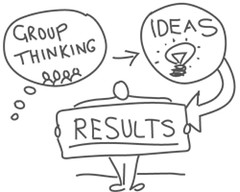“The real heart of Web 2.0 is collective intelligence, which I have defined as harnessing the network effect to build applications that get better the more people use them.”
— Tim O’Reilly, founder of O’Reilly Media
Collective intelligence is best defined as a shared or group intelligence that emerges from the collaboration and competition of many individuals. This concept is nothing new. For example, political parties have always worked with this concept, by taking the views of people to form policies, select their candidates and run election campaigns.
Collective intelligence within the Web 2.0 and organizations
 Collective intelligence plays a huge role within web 2.0. One of the best examples of collective intelligence is Wikipedia. Anyone can add information to an existing page or create a new page. Pages also hyperlink to other areas of the website that people have edited. Search engines like Google and social networking sites such as Facebook are also great examples of sites that depend on a collective aspect to give users the intended experience.
Collective intelligence plays a huge role within web 2.0. One of the best examples of collective intelligence is Wikipedia. Anyone can add information to an existing page or create a new page. Pages also hyperlink to other areas of the website that people have edited. Search engines like Google and social networking sites such as Facebook are also great examples of sites that depend on a collective aspect to give users the intended experience.
With collective intelligence on the rise, companies are starting to integrate this concept into their product development processes.
According to this Slideshare presentation on collective intelligence, “for collective intelligence to work to it’s full potential it needs people and companies to be open about their ideas to the rest of the public on the web so their products can be improved.”
It explains that Amazon is an example of a company that uses collective intelligence. The website is made up of people who buy and sell from each other. It also recommends items that may interest you, based on what you have already looked at. Customer reviews can also be heavily influential when choosing a product. You are essentially basing your opinion off of the opinions of other members of the public.
Collective intelligence: Employed with the help of software
Top-notch companies such as At&T, Wal-Mart and Pitney Bowes have found a way to delve into the collective intelligence of their workforce, organize the resulting suggestions, and then predict which ones are most likely to succeed. They do this by using software that allows them to collect feedback, organize them, and innovate the development process.
Tapping into collective intelligence will help structure collaboration within your company, which is the key to reducing labour, saving time and money, and improving the customer experience. Integrate collective intelligence into your company’s development process by trying OneDesk out for free today; its feedback gathering system combined with social collaboration tools make it easy to capture feedback, engage with customers, analyze and implement the right feedback and deliver the right products.
